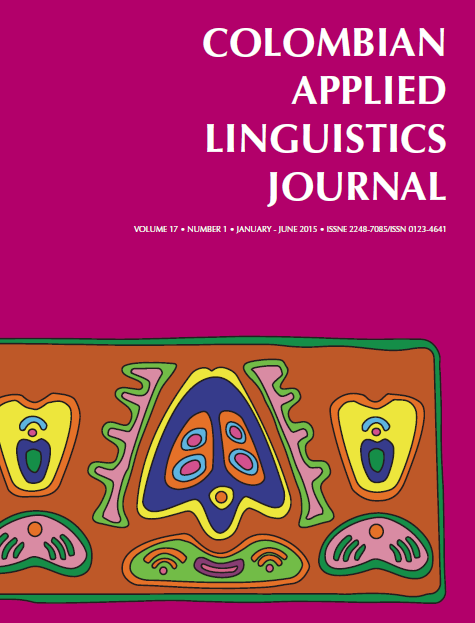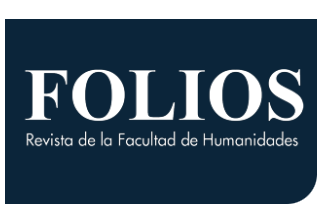DOI:
https://doi.org/10.14483/udistrital.jour.calj.2015.1.a10Publicado:
2015-05-06Número:
Vol 17, No 1 (2015) January-JuneSección:
Reflexiones sobre la prácticaWorld englishes and English language teaching: a pragmatic and humanistic approach
Lenguas inglesas del mundo y la enseñanza del inglés: un enfoque pragmático y humanístico
Palabras clave:
ELT, enfoque humanístico a ELT, enfoque pargmático a ETL, lenguas inglesas del mundo (es).Palabras clave:
ELT, a humanistic approach to ELT, a pragmatic approach to ELT, World Englishes (en).Descargas
Resumen (en)
Seidlhofer (2005) describes the current status of English as an “unstable equilibrium.” In many ways this analogy regarding the current state of affairs with English language teaching (ELT) is appropriate. Taking a World Englishes (WE) perspective, this paper presents various mismatches between teaching goals and objectives vis-à-vis the teaching and learning outcomes in ELT. The paper then makes the argument that in order for more successful English language teaching and learning to take place, a pragmatic and humanistic approach needs to be adopted. An outline of such an approach is discussed.
Resumen (es)
Seidlhofer (2005) describe el estado actual de inglés como un “equilibrio inestable”. En muchos sentidos, esta analogía con respecto a la situación actual con la enseñanza del idioma Inglés (ELT) es apropiado. Tomando una perspectiva de las lenguas inglesas del mundo (World Englishes), este trabajo presenta varios desajustes entre las metas y los objetivos en relación con los resultados de enseñanza y aprendizaje en la enseñanza ELT. En el documento se presenta, entonces, el argumento de que para que la enseñanza y el aprendizaje del idioma Inglés tengan lugar con más éxito, un enfoque pragmático y humanista debe ser adoptado. Se discute un esquema de este tipo de enfoque.
Referencias
Aloni, N. (1997). A redefinition of liberal and humanistic education. International Review of Education, 43, 87-107.
Alptekin, C. (2002). Towards intercultural communicative competence in ELT. ELT Journal, 56, 57-64.
Baumgartner, R. (2007). Teaching world Englishes. In B. B. Kachru, Y. Kachru, & C. L. Nelson (Eds.), Handbook of world Englishes (pp. 661-679). Oxford, UK: Blackwell.
Berns, M. (1990). Contexts of competence: Social and cultural considerations in communicative language teaching. New York: Plenum Press.
Bhatia, T. K. (2014). Review of translingual practice: Global Englishes and cosmopolitan relations. World Englishes, 33, 294-297.
Blommaert, J., & Verschueren, J. (Eds.). (1991). The pragmatics of international and intercultural communication. Amsterdam: Benjamins.
Brown, J. D. (1995). Elements of language curriculum: A systematic approach to program
development. Boston, MA: Heinle.
Brutt-Griffler, J. (2002). World English: A study of its development. Clevedon, UK: Multilingual Matters.
Canagarajah, S. A. (1999). Resisting linguistic imperialism in English teaching. Oxford, UK: Oxford University Press.
Canagarajah, S. A. (2006). Changing communicative needs, revised assessment objectives: Testing English as an international language. Language Assessment Quarterly, 3, 229-242.
Canagarajah, S. A. (2013). Translingual practice: Global Englishes and cosmopolitan relations. New York: Routledge.
Chalhoub-Deville, M., & Wigglesworth, G. (2005). Rater judgment and English language speaking proficiency. World Englishes, 24, 383-391.
Coffin, C. (2003). Exploring different dimensions of language use. ELT Journal, 57, 11-18.
Crystal, D. (1997). English as a global language. Cambridge, UK: Cambridge University Press.
Derwing, T., & Munro, M. (2005). Second language accent and pronunciation teaching: A research based approach. TESOL Quarterly, 39, 379-397.
Ellis, R. (1993). The structural syllabus and second language acquisition. TESOL Quarterly, 27, 91-113.
Fukuda, K., & Sasaki, M. (1995). Immersion program ni kanren suru shisatsu hokoku [Task group report on immersion programs]. Paper presented at the Niigata University General Education and Language Group, Niigata City, Japan.
Ferris, D. (1999). The case against grammar correction in L2 writing classes: A response to Truscott (1996). Journal of Second Language Writing, 8, 1-11.
Gadamer, H. G. (1975). Truth and method. New York: Crossroad.
González, A. (2010). English and English teaching in Colombia: Tensions and possibilities in the expanding circle. In A. Kirkpatrick (Ed.), The Routledge Handbook of World Englishes (pp. 332-351). New York: Routledge.
Graddol, D. (1997). The future of English. London: The British Council.
Graddol, D. (1999). The decline of the native speaker. AILA Review, 13, 57-68.
Guariento, W., & Morley, J. (2001). Text and task authenticity in the EFL classroom. ELT Journal, 55, 347-353.
Hadley, G. S. (1999). Innovative curricula in tertiary ELT: A Japanese case study. ELT Journal, 53, 92-99.
Hamp-Lyons, L., & Davies, A. (2008). The Englishes of English tests: Bias revisited. World Englishes, 27, 26-39.
Jenkins, J. (1998). Which pronunciation norms and models for English as an international language? ELT Journal, 52, 119-126.
Jenkins, J. (2000). The phonology of English as an international language: New models, new norms, new goals. Oxford, UK: Oxford University Press.
Jenkins, J. (2002). A sociolinguistically based, empirically researched pronunciation syllabus for English as an international language. Applied Linguistics, 23, 83-103.
Jenkins, J. (2006). Current perspectives on teaching world Englishes and English as a lingua franca. TESOL Quarterly, 40,157-181.
Kachru, B. B. (Ed.). (1982). The other tongue: English across cultures. Urbana, IL: University of Illinois Press.
Kachru, B. B. (1985). Standards, codification and sociolinguistic realism: The English language in the outer circle. In R. Quirk & H. G. Widdowson (Eds.), English in the world (pp. 11-30). Cambridge, UK: Cambridge University Press.
Kachru, B. B., & Nelson, C. L. (1996). World Englishes. In S. L. McKay & N. Hornberger (Eds.), Sociolinguistics and language teaching (pp. 71-102). Cambridge, UK: Cambridge University Press.
Kirkpatrick, A. (2007). World Englishes: Implications for international communication and English language teaching. Cambridge, UK: Cambridge University Press.
Levis, J. (2005). Changing contexts and shifting paradigms of pronunciation teaching. TESOL Quarterly, 39, 369-377.
Little, D., Devitt, S., & Singleton, D. (1988). Authentic texts in foreign language teaching: Theory and practice. Dublin: Authentik.
Lowenberg, P. H. (2000). Non-native varieties and the sociopolitics of English proficiency assessment. In J.K. Hall & W. G. Eggington (Eds.), The sociopolitics of English language teaching (pp. 67-82). Clevedon, UK: Multilingual Matters.
Matsuda, A. (2003). Incorporating world Englishes in teaching English as an international language. TESOL Quarterly, 37, 719-729.
Matsuda, A. (2006). Negotiating ELT assumptions in EIL classrooms. In J. Edge (Ed.), (Re) locating TESOL in an age of empire (pp. 158-170). Hampshire, UK: Palgrave Macmillan.
Pasternak, M., & Bailey, K. M. (2004). Preparing nonnative and native English-speaking teachers: Issues of professionalism and proficiency. In L. D. Kamhi-Stein (Ed.), Learning and teaching from experience: Perspectives on nonnative English-speaking professional (pp. 155-175). Ann Arbor: University of Michigan Press.
Peacock, M. (1997). The effect of authentic materials on the motivation of EFL learners. ELT Journal, 51, 144-156.
Phillipson, R. (1992). ELT: The native speaker’s burden? ELT Journal, 46, 12-18.
Rajagopalan, K. (2004). The concept of “World English” and its implications for ELT. ELT Journal, 58, 111-117.
Seidlhofer, B. (2002). Habeas corpus and divide et impera: “Global English” and applied linguistics. In K. Spelman Miller & P. Thompson (Eds.), Unity and diversity in language use (pp. 198-217). London: Continuum.
Seidlhofer, B. (2004). Research perspectives on teaching English as a lingua franca. Annual Review of Applied Linguistics, 24, 209-239.
Seidlhofer, B. (2005). Standard future of half-baked quackery? In C. Gnutzmann & F. Intemann (Eds.), The globalization of English and the English language classroom (pp. 159-173). Tübingen, Germany: Narr.
Snow, M. A., Kamhi-Stein, L. D., & Brinton, D. M. (2006). Teacher training for English as a lingua franca. Annual Review of Applied Linguistics, 26, 261-281.
Spencer-Oatey, H. (Ed.). (2000). Culturally speaking. London: Continuum.
Strevens, P. (1983). What is “Standard English”? In L. Smith (Ed.), Readings in English as an international language (pp. 87-93). Oxford, UK: Pergamon.
Tripathi, P. D. (1998). Redefining Kachru’s “Outer Circle” of English. English Today, 14, 55-58.
Truscott, J. (1996). The case against grammar correction in L2 writing classes. Language Learning, 46, 327-369.
Widdowson, H. G. (1994). The ownership of English. TESOL Quarterly, 28, 377-389.
Wilkins, D. (1976). Notional syllabuses. Oxford: Oxford University Press.
Wong, V., Kwok, P., & Choi, N. (1995). The use of authentic materials at tertiary level. ELT Journal, 49, 318-322.
Cómo citar
APA
ACM
ACS
ABNT
Chicago
Harvard
IEEE
MLA
Turabian
Vancouver
Descargar cita
Métricas
Licencia
Esta publicación tiene licencia de Creative Commons Reconocimiento-No comercial- Sin obras derivadas 2.5 Colombia. El lector podrá leer, copiar y distribuir los contenidos de esta publicación bajo los términos legales de Creative Commons, Colombia.
Para mayor información referirse a http://creativecommons.org/licenses/by-nc-nd/2.5/co/








